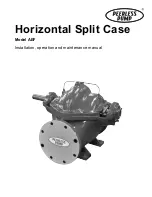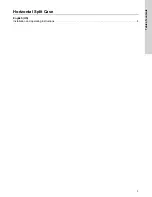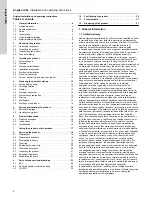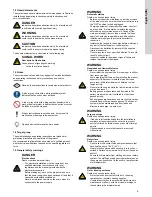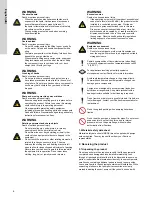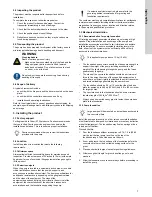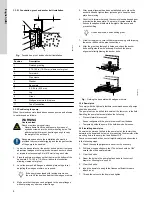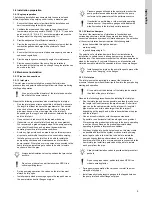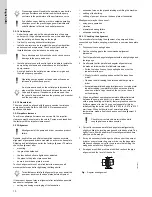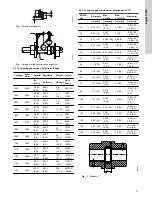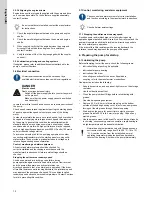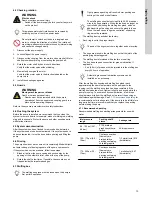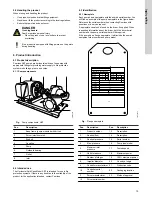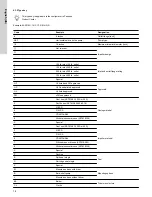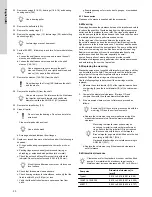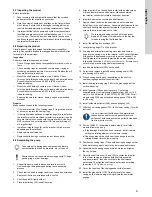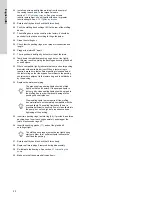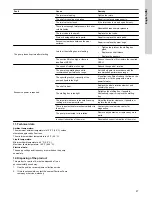
4.2 Checking rotation
WARNING
Electric shock
Death or serious personal injury
‐
Switch off the power supply before you start any work
on the product.
Three-phase motor shaft rotation can be reversed by
switching any two of the three power leads.
Do not attempt to switch any leads in a single-phase
motor to change the direction of rotation. The rotation of
most single-phase motors is determined by internal wiring
and cannot be changed easily.
1.
Disconnect the power supply.
2.
Lockout-Tagout the power supply.
3.
Disconnect the coupling from the motor and pump shaft. Motor
shaft spins without driving or contacting the pump shaft.
4.
Rotate the motor shaft by hand in both directions.
Verify that the motor spins without binding.
5.
Momentarily energize the motor.
Verify that the motor spins in the direction indicated on the
pump volute.
6.
Install the coupling and guards.
4.3 Guards
WARNING
Moving machine parts or blades
Death or serious personal injury
‐
Guards must not be removed while the pump is
operational. Ensure an approved coupling guard is in
place before operating the pump.
Refer to the accessory manufacturer's safety instructions.
4.4 Flushing the system
Before the pump is installed, we recommend that you clean the
system to remove debris, for example, stubs of welding rod, welding
slag, and loose scale. Protect the pump and other sensitive parts
with startup strainers.
4.5 System decontamination
After the system has been flushed to remove debris, determine
if the system needs to be decontaminated. If the system needs to
be decontaminated, it must be done before priming and filling the
pump.
4.6 Priming
The pump should not be run unless it is completely filled with liquid,
as there is danger of damaging some of the pump components.
If the system has suction pressure, follow these steps:
1.
Bleed all air from the pump casing and suction pipe by the
opening of the automatic relief valve at the top of the pump.
2.
Rotate the shaft a few times, if possible, to evacuate any air
trapped inside the impeller passages.
4.7 Stuffing box
The stuffing box gland must be loose when the pump is
first put into operation.
Tightly pressed packing will result in burnt packing and
scoring of the shaft or shaft sleeve.
The stuffing box should slowly leak fluid, 40-60 drops per
minute, during operation. When the leak can no longer be
controlled by adjusting the stuffing box gland, add one
additional ring of packing and ensure the gland is loose.
When the leak can no longer be controlled, all packing
rings must be replaced.
•
The stuffing box is packed at the factory.
•
Each ring is cut to the proper length.
The end of the rings must come together and not overlap.
•
The rings are placed in the stuffing box so that the joints of the
packing rings are staggered.
•
The stuffing box is furnished with a lantern or seal ring.
•
The box has a tapped connection for grease lubrication, if
applicable.
- 3 oz. (89 mL) of grease must be injected into the stuffing box
every 24 hours of operation.
Automatic grease seal lubrication systems can be
installed as an accessory.
After the stuffing box housing and stuffing box gland reach
approximately the same temperature as the pump parts, the
running-in of the stuffing box gland has been completed. If the
stuffing box leaks too much, tighten it slightly and evenly while the
pump is running. To ensure continuous lubrication, a few drops
should always drip from the stuffing box to protect the packing or
shaft sleeve against damage. See
for
recommendations for leakage rate. If the pump is to be left idle for a
long period of time, we recommend that you replace the packing
before starting the pump.
4.7.1 Recommended packing
Recommended stuffing box packing arrangements for use with
water:
Inlet pressure
range
Packing shaft/
sleeve
Leakage rate
6.0 - 100 psi (0.41 -
6.9 bar)
PTFE braided
graphite synthetic-
lattice
60 drops/minute
100 - 175 psi (6.9 -
12 bar)
Continuous carbon
filament yarn,
braided lattice
packing containing
colloidal graphite
1/3 pint/minute (0.16
liters/minute)
175 - 250 psi (12 -
17 bar)
Continuous carbon
filament yarn,
braided lattice
packing containing
colloidal graphite
1 pint/minute (0.47
liters/minute)
13
English (US)

